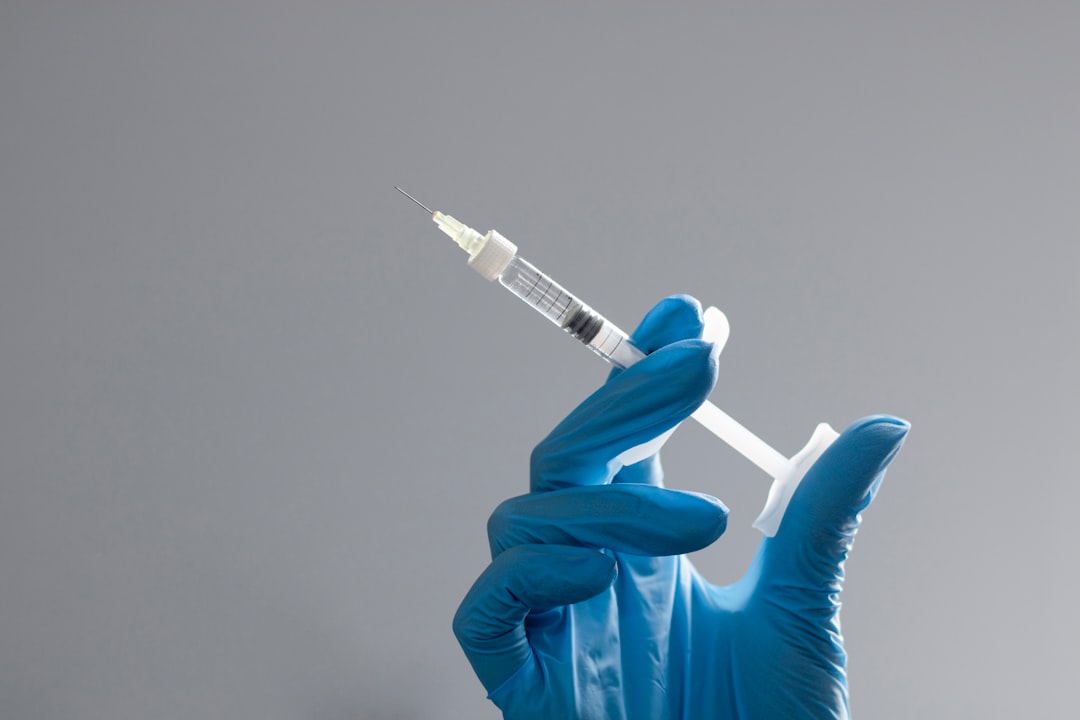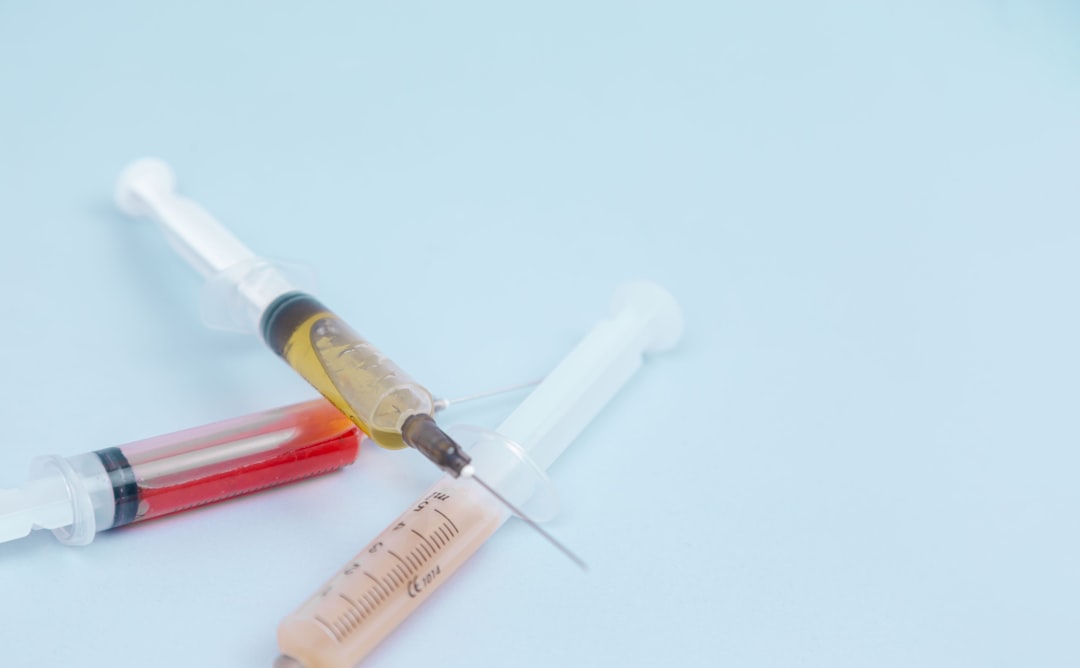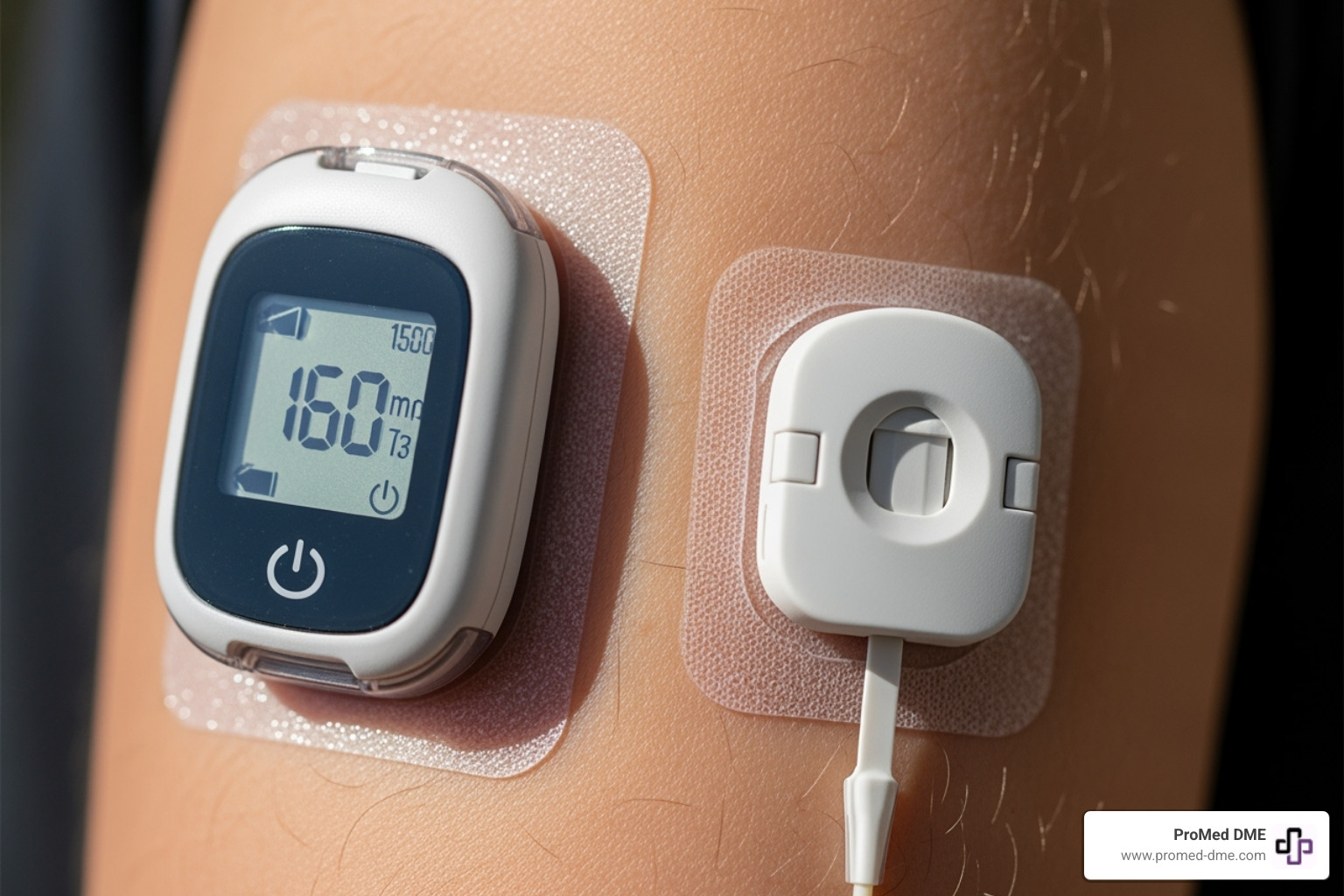Ready, Set, CGM! How to Easily Obtain Your Continuous Glucose Monitor
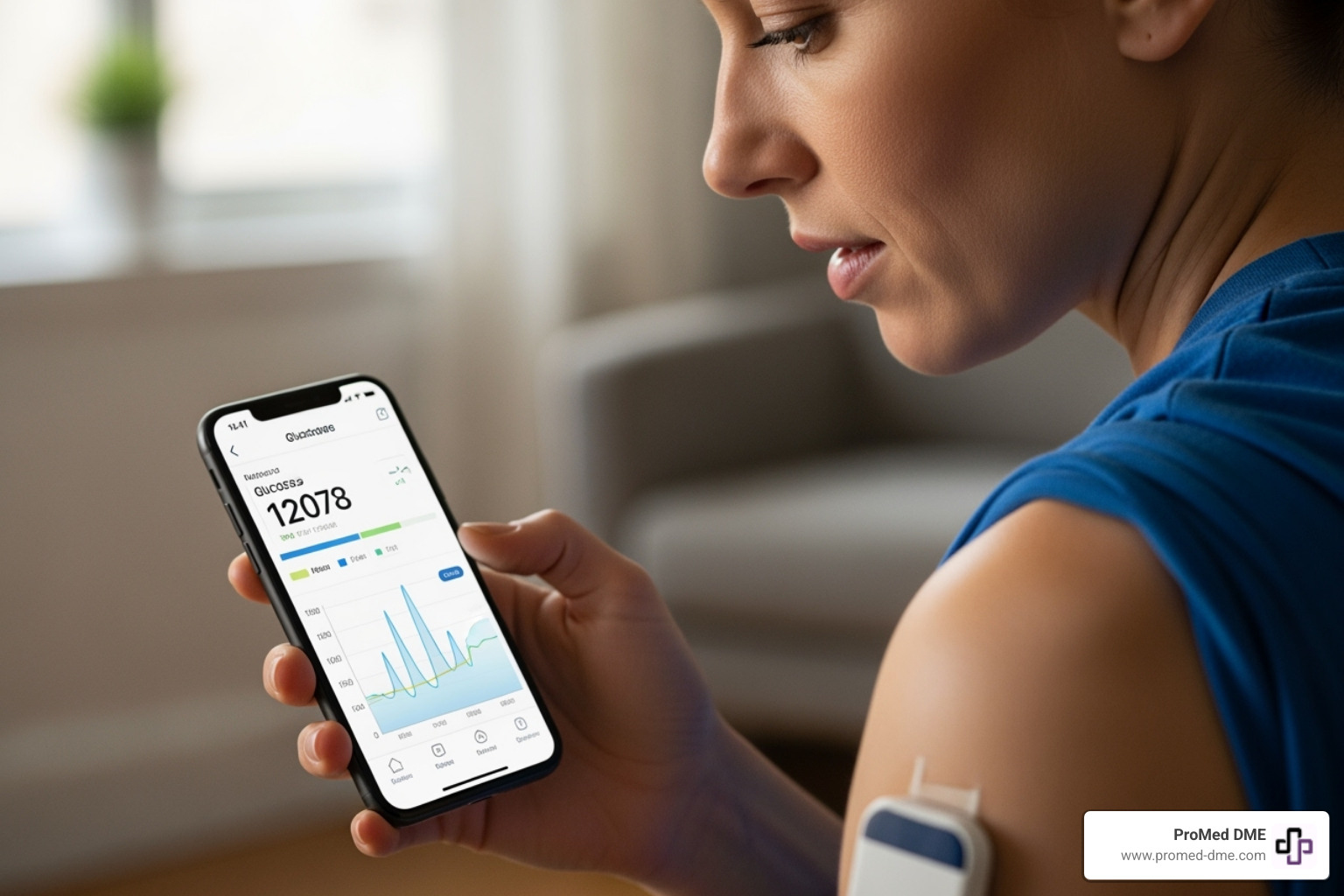
Your First Step Towards Smarter Glucose Monitoring
If you're wondering how to get cgm to gain new health insights, you're not alone. Here's a quick overview of the process:
- Talk to your doctor. Discuss if a CGM is right for you.
- Get a prescription. Most CGMs require one.
- Verify insurance coverage. Understand your benefits.
- Order your supplies. Work with a trusted supplier like ProMed DME.
Continuous Glucose Monitors (CGMs) are wearable devices that track your glucose 24/7, eliminating constant finger pricks. They provide a complete picture of how your body responds to food, activity, and medication.
This detailed data helps you make smarter decisions for better health outcomes, whether you have diabetes or are exploring personalized nutrition.
Getting a CGM might seem complex, but we'll guide you through each step. Our goal is to simplify the process, helping you take control of your health.
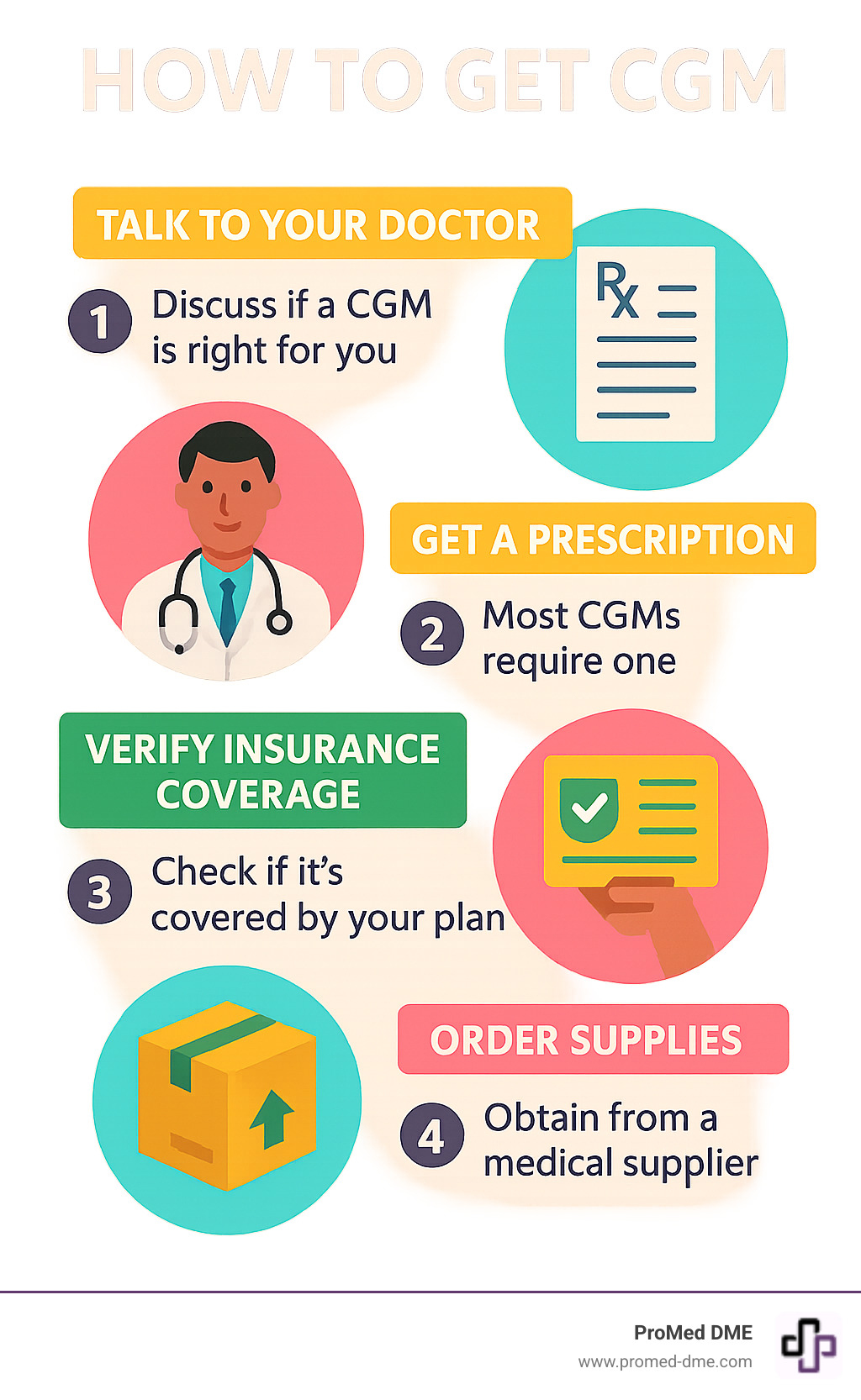
Basic how to get cgm vocab:
Understanding CGMs and Who Can Benefit
A Continuous Glucose Monitor (CGM) is a device that constantly checks your glucose levels day and night. Unlike traditional finger-prick meters that give a single reading, a CGM provides a continuous stream of data, showing you the full story of your glucose trends for a clearer picture of what's happening inside your body.
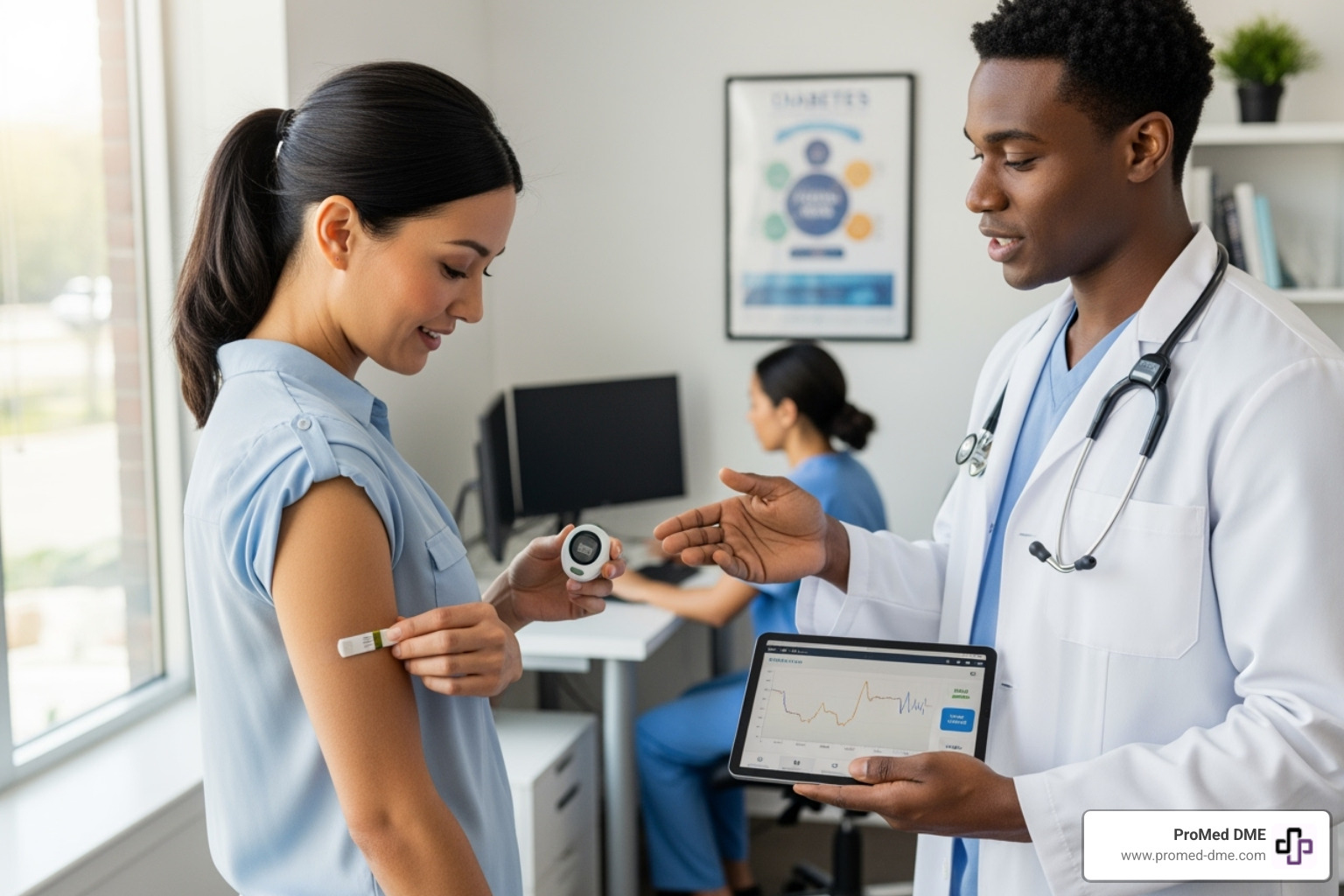
How CGMs Work
A CGM system has three main parts:
- A small sensor: A patch with a tiny filament that sits just under your skin, usually on your arm or belly. It measures glucose in your interstitial fluid (the fluid around your cells). Application is typically quick and easy.
- A transmitter: This reusable piece attaches to the sensor and wirelessly sends glucose readings to your display device.
- A display device: This can be a dedicated receiver, an insulin pump, or a smartphone app. It shows your real-time glucose numbers, trend graphs, and can provide alerts for high or low levels.
After a short warm-up period (as little as 30 minutes), the sensor begins measuring your glucose every few minutes, 24/7.
It's important to know that CGMs measure glucose in interstitial fluid, not blood, which can cause a slight delay (a few minutes) compared to a blood glucose meter. This is important to remember if your symptoms don't match your CGM reading, especially during rapid glucose changes.
A key feature is trend arrows, which show if your glucose is rising, falling, or steady, and how fast. This allows you to be proactive and take action before a high or low becomes a bigger issue.
This continuous data helps you understand your Time in Range (TIR)—the percentage of time your glucose stays within your target range. Studies show that more time in range is linked to improved well-being and a lower A1C.
The best part for many is fewer fingersticks! While you should always check with a traditional meter if your symptoms don't match your CGM, these devices dramatically reduce painful pokes.
Who is a Candidate for a CGM?
Originally for Type 1 diabetes, CGMs now benefit a wide variety of people. If you're wondering how to get cgm because you think it could help you, you're likely right.
CGMs are often recommended for people who have:
- Type 1 Diabetes: CGMs are invaluable for those on complex insulin plans (pumps or multiple daily injections), providing vital data to adjust doses and prevent dangerous highs and lows.
- Type 2 Diabetes: Increasingly recommended, especially for those who:
- Use insulin therapy.
- Experience large glucose swings.
- Have had low blood sugar episodes or hypoglycemia unawareness (not feeling the warning signs of low blood sugar).
- Are pregnant (gestational diabetes).
- Frequent Glucose Fluctuations: A CGM can help you and your doctor spot patterns and triggers for more stable control.
- People on intensive insulin therapy: For Type 1 or Type 2, a CGM provides the real-time data needed for precise adjustments.
CGMs are also popular for non-diabetic uses:
- Prediabetes: To understand how food and exercise affect glucose and make lifestyle changes to prevent Type 2 diabetes.
- Obesity: Gaining insight into your body's response to food and activity can be a powerful tool for weight management.
- Personalized Nutrition: A CGM can offer fascinating insights into how your body reacts to food, activity, and stress, helping you fine-tune your diet for better overall health. For these users, over-the-counter (OTC) options, like the Dexcom Stelo Glucose Biosensor (for adults 18+ not on insulin), are becoming available.
The Step-by-Step Guide on How to Get a CGM
Getting a CGM doesn't have to be a maze. We've broken down the journey into four simple steps to help you understand how to get cgm and gain valuable health insights.
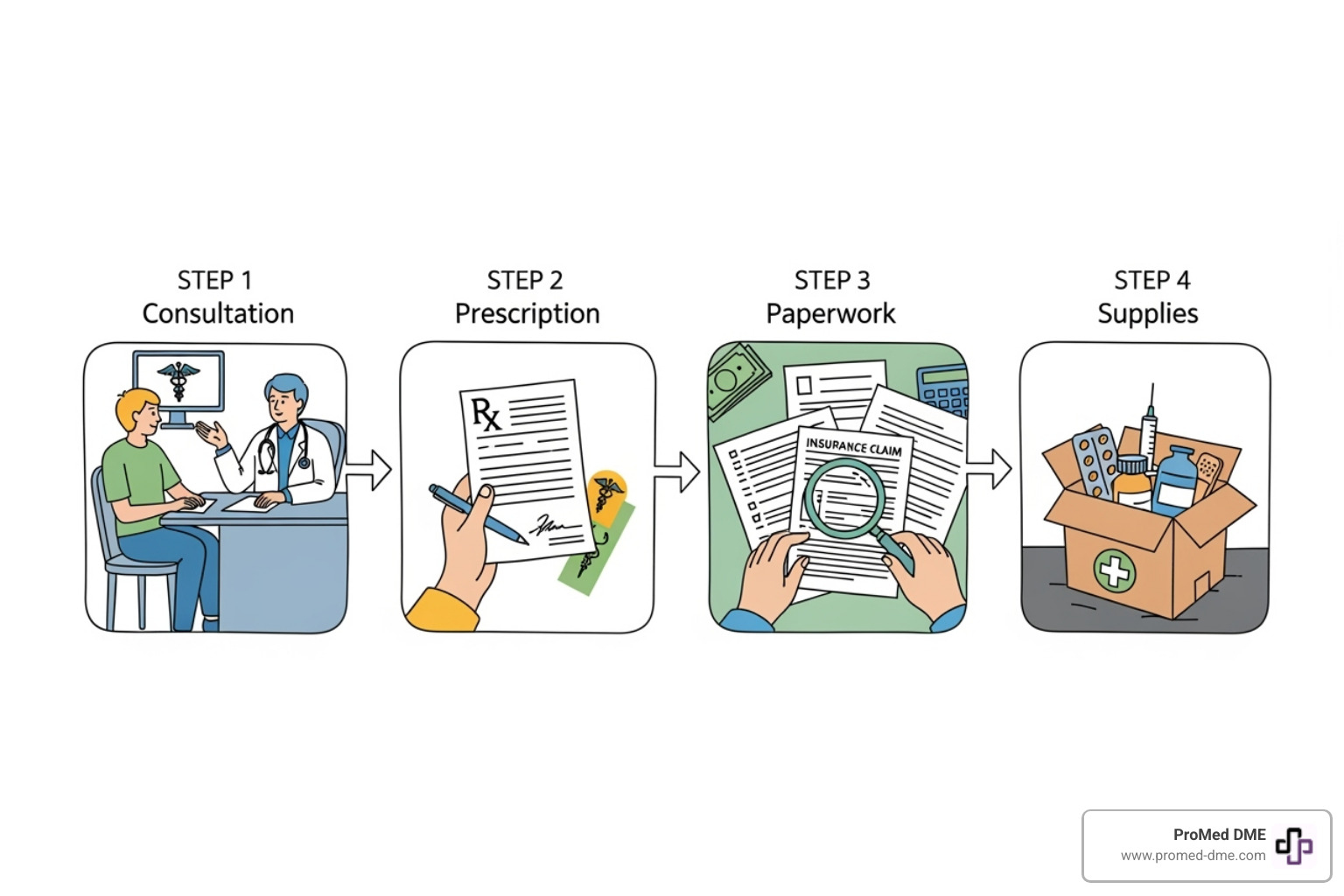
Step 1: Talk to Your Healthcare Provider
Your healthcare provider is your guide and will help determine if a CGM is right for you.
Preparing for Your Appointment: Before you go, consider your biggest glucose management challenges (e.g., frequent highs/lows, fingerstick hassle) and your goals (e.g., lower A1C, understanding food impacts). Bring any blood sugar records to show you're engaged in your care.
Discussing Your Goals: Clearly state why you're interested. For example: "I want a CGM to see how meals and exercise impact my glucose and to reduce my risk of lows." Mentioning your goal to improve your "time in range" is also effective.
Self-Advocacy: Doctors may not always suggest a CGM. It's important to advocate for yourself. You are the expert on your body and daily challenges, and simply asking can often lead to getting the care you need. Be ready to explain how a CGM could help you manage your diabetes better.
Asking for a CGM: Be direct. Try saying, "I've been researching CGMs and think one could really help me. Can we discuss if it's a good option for me and how I can get a prescription?"
Step 2: How to Get a CGM Prescription
Most CGMs are medical devices requiring a prescription from a licensed healthcare provider. This ensures the device is appropriate for your health needs and that you receive guidance on its safe use.
The Role of a Prescription: Your doctor's prescription will specify the CGM system (e.g., Dexcom G7, FreeStyle Libre 3) and the quantity needed for a set period, like a 90-day supply.
Medical Necessity: For a prescription and insurance coverage, your doctor must demonstrate "medical necessity." This involves documenting your diagnosis, treatment plan (e.g., insulin use), glucose history, and how a CGM will improve your health outcomes.
Over-the-Counter (OTC) Biosensors: Some biosensors, like the Dexcom Stelo Glucose Biosensor System, are available over-the-counter for adults 18+ who are not on insulin. These are great for learning how lifestyle choices affect glucose.
OTC Limitations: Be aware that OTC CGMs differ from prescription devices. They might:
- Not have critical safety alerts for dangerously high or low glucose.
- Cost more out-of-pocket as they are not typically covered by insurance.
- Not be for treatment decisions, but rather for general lifestyle guidance.
Doctor's Evaluation: We always recommend chatting with your doctor, even if you're considering an OTC option, to ensure you choose the best device for your needs.
Step 3: Navigating Insurance Coverage and Approval
Understanding how your insurance works can help keep your costs down.
Durable Medical Equipment (DME) Benefit vs. Pharmacy Benefit: CGMs can be covered in two ways:
- Durable Medical Equipment (DME) Benefit: Some CGMs (e.g., certain Dexcom systems) are covered as DME, meaning you'll work with a specialized supplier like us.
- Pharmacy Benefit: Others (e.g., FreeStyle Libre systems) are typically covered under your pharmacy benefit.
This can affect your copay and which supplier you use. ProMed DME works with most insurance plans and can help you figure this out.
Medicare Criteria: Medicare covers CGMs for eligible patients, generally those with Type 1 or Type 2 diabetes on intensive insulin therapy or who have had problematic hypoglycemia. Check the CMS website for the latest details.
Medicaid Coverage: Medicaid programs generally cover CGMs for individuals with Type 1, Type 2, and gestational diabetes, but rules vary by state.
Commercial Insurance Policies: Private insurance plans have varied CGM coverage. Many cover them but have specific requirements, such as a diabetes diagnosis, insulin treatment, or a history of hypoglycemia. For many commercially insured patients, the out-of-pocket cost can be as low as $0 to $60 per month.
Prior Authorization: Many plans require prior authorization, where your doctor sends documents to the insurance company explaining why the CGM is medically necessary.
ADA Standards of Care: Your provider may reference guidelines like the ADA Standards of Care to support your case.
Required Documentation: Your doctor's detailed notes in your electronic health records (EHRs) are key for insurance approval. At ProMed DME, our on-staff nurse helps manage documentation to make the process as smooth as possible.
What If Insurance Says No? Exploring Your Options
An insurance denial for your how to get cgm journey can be disheartening, but it's not the final answer. You can often appeal the decision or explore other ways to get the monitoring you need.
If you receive a denial, read the letter carefully to understand the reason. It could be a simple issue like missing paperwork. Your doctor's office can submit an appeal with more detailed information, such as chart notes or a letter of medical necessity, to strengthen your case.
Even with coverage, costs like deductibles and copays can be a concern. If costs are too high or you lack CGM coverage, you still have options.
How to Get a CGM Without Full Insurance Coverage
If insurance isn't an option or costs are prohibitive, explore these alternatives for how to get cgm:
- Patient Assistance Programs (PAPs): Many CGM manufacturers offer PAPs to help with costs, providing devices at a free or reduced price. Check the websites of brands like Dexcom and FreeStyle Libre for details.
- Manufacturer Free Trials: Look for free trials or samples (e.g., a 10-day sensor). This is a great way to experience a CGM's benefits without financial commitment.
- Prescription Discount Cards: Services like GoodRx or SingleCare can offer significant savings on the cash price of some CGMs, especially those covered under a pharmacy benefit.
- Membership Warehouses: Pharmacies at stores like Costco or Sam's Club may offer competitive cash prices on medical supplies, including CGMs.
- Professional CGM (Short-Term Diagnostic): Ask your doctor about wearing a CGM for a short period (7-14 days). The data is analyzed by your provider and can provide powerful insights. This is often covered by insurance and can strengthen your case for a personal CGM.
- Over-the-Counter (OTC) Options: Devices like the Dexcom Stelo Glucose Biosensor System are available without a prescription for individuals not on insulin. Be aware they are typically not covered by insurance and may lack the critical safety alerts of prescription devices.
At ProMed DME, we work with most insurance plans to minimize your out-of-pocket expenses and can help you explore these affordability options.
Frequently Asked Questions about Obtaining a CGM
Figuring out how to get cgm can be confusing. Here are answers to the most common questions to help you feel more confident.
How much does a CGM typically cost?
Cost is a major concern, but the price of a CGM varies and is often more affordable than you might expect.
With insurance coverage, most commercially insured patients pay between $0 to $60 per month for their supplies, especially for systems like the FreeStyle Libre.
Without insurance, the cash price can be steep, with monthly supplies potentially costing several hundred dollars.
However, there are many ways to lower these costs. Patient assistance programs, manufacturer trials, and discount cards can make a huge difference. At ProMed DME, we work with your insurance to get you the lowest possible out-of-pocket cost.
Do I still need to do fingerstick checks with a CGM?
Reducing painful finger pricks is a key reason many people want a CGM. The great news is you'll need far fewer fingersticks. Many modern CGMs are FDA-approved for making treatment decisions without a confirmatory fingerstick.
However, a fingerstick is still your best friend in a few situations:
- When your symptoms don't match your CGM reading. Always trust your body and double-check.
- During rapid glucose changes, as CGMs can have a slight delay compared to blood sugar.
- If you're ever uncertain about a reading before making a major treatment decision, like taking insulin.
Some older models may still require occasional calibration. Keep a traditional meter handy as a backup, not as your daily routine.
How long does the approval process take?
The approval timeline varies depending on your specific situation.
Insurance verification usually takes a few days to a couple of weeks. Our team at ProMed DME works quickly to keep this moving.
Prior authorization is the most variable step. If your insurance requires it, your doctor's office must submit documentation for review. This can add several days to a few weeks to the process.
Once approved, our processing time is fast. We handle the paperwork and ship your CGM supplies directly to you with free shipping.
Some patients get their CGM within a week or two, while others might wait longer. The key is communication, and we're always here to provide updates on your order status.
Conclusion: Take Control of Your Diabetes Management Today
Learning how to get a CGM is a great first step towards smarter, more informed health management. We've covered the key steps: talking to your healthcare provider, getting a prescription, navigating insurance, and ordering your supplies.
A CGM empowers you to make proactive decisions about food, activity, and medication. This leads to better glucose control, fewer worries, and an improved quality of life, helping you partner with your body for better health.
At ProMed DME, we believe this journey should be smooth and stress-free. As a dedicated medical supply company in Stuart, Florida, we ship top-quality products across the United States with exceptional customer service.
Our "worry-free process" means we handle the heavy lifting: contacting your doctor, securing prescriptions, verifying insurance, and processing paperwork. With a dedicated nurse on staff, free shipping, and a commitment to working with most insurance plans, we minimize your costs and make getting a CGM as easy as possible.
Don't let the thought of how to get a CGM feel overwhelming. We're here to be your partner. Ready to take control?
Explore your diabetes supply options with ProMed DME today!
Related Resources & Articles
Stay informed with our informative blog posts.
Discover the ProMed Advantage
& Try Our Products
We offer free shipping and legendary customer service to ensure you receive the
best DME products for your needs.

